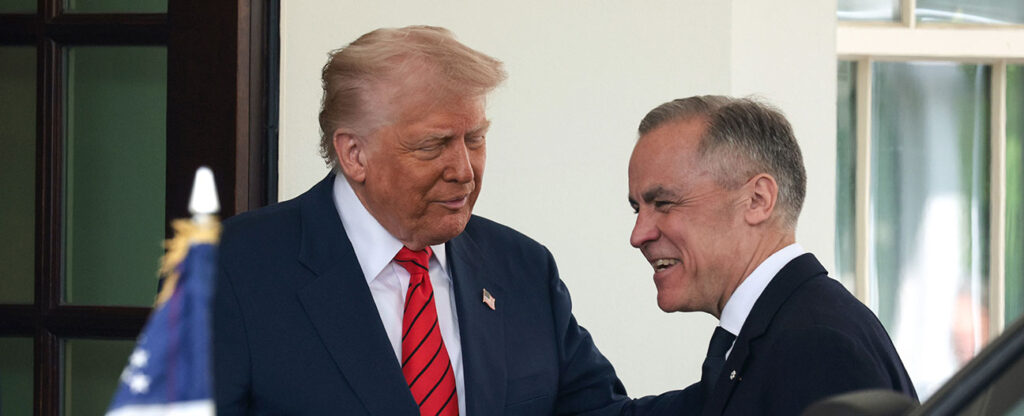U.S. President Donald Trump greets Canadian Prime Minister Mark Carney at the White House in May 2025. AFP/GETTY IMAGES
THE WATCH STAFF
Days before his electoral win on April 28, 2025, Canadian Prime Minister Mark Carney unveiled a plan to increase Canadian defense spending by $18 billion by 2030. Carney’s plan would bring Canada in line with a long-standing NATO spending goal of 2% of member states’ gross domestic product (GDP) for defense.
“It is possible we may need to do more,” Carney said at an Ontario campaign rally earlier in April. Canada has increased its force projection and upgraded its military hardware for several years, most recently in its 2024 defense plan, Our North, Strong and Free, unveiled in April 2024. That plan called for Canada to spend $5.9 billion on a five-year defense plan that focuses on the defense of its Arctic territory and $53 billion over the next 20 years with major investments in weapons systems, war and reconnaissance planes, Arctic patrol vehicles, and upgrades in housing and other support for the troops. Carney’s pledge promises to nearly triple that investment as the North American nation with the most Arctic territory confronts an increasingly competitive environment in that hard-to-defend region.
An analysis by the Canadian Defence Review, a Canadian military affairs website, found that Carney’s plans signal a significant acceleration of the Our North strategy. Carney has argued that Canada enjoys one of the best debt-to-GDP ratios in the world and can afford to borrow to rapidly modernize the Canadian Armed Forces (CAF). The guideposts for spending cover four core priorities, according to the journal’s review.
- Modernize Canada’s North American Aerospace Defense Command commitments, especially amid increasing Arctic tension.
- Expand cyber defense infrastructureto address asymmetric threats.
- Enhance recruitment and retentionin the CAF, potentially with increased wages, benefits and support systems.
- Modernize procurement, including timelines for naval and air fleet renewals.
Carney, who met with U.S. President Donald Trump in early May 2025, has amplified a message that increased Canadian defense spending is necessary for national security and fulfilling its obligations to its allies. The spending plan, noted the Defence Review, accelerates a trend in Canadian views toward national defense. “What is clear, however, is that defence spending is no longer a footnote in Canadian politics — it is rapidly becoming a pillar of national resilience, economic renewal, and global positioning,” the Review stated. Canada currently spends about 1.7% of its GDP on defense. Of the 24 NATO members, 22 countries have announced plans to meet the 2% threshold.

